Rubric: Interaction of bodies
Pressure is a scalar quantity that is equal to the ratio of the force that acts perpendicular to the surface to the area of this surface.
S is the area of the surface or support of the body;
F - pressure force (any force that acts on a body perpendicular to the surface, most often it is the weight of the body).
Unit of pressure - pascal(Pa). Named after the French scientist Blaise Pascal.
[p] \u003d 1 Pa \u003d 1N / m 2
Pascal- the pressure that a normal force of 1 N creates on an area of 1 m 2.
It can be seen from the formula that the result of the action of a force on the surface depends not only on its magnitude, but also on the area of support of the pressing body. The picture shows a man in boots walking through the snow, sinking deep with each step. But if he puts on skis, he can walk without falling into the snow. On skis and without a person acts on the snow with the same force, which is equal to its weight. But the action of this force is different in both cases, because the surface area on which the person presses is different.
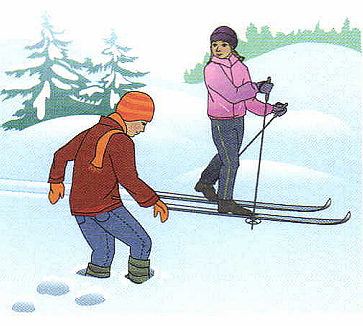
The area of the sole is about 10 times less than the surface area of the ski, so a person on skis presses on every square centimeter of the snow surface area with a force ten times less.
A task
Calculate the pressure of a 60 kg skater on the ice if the width of the skate blade is 4 mm and the length of the blade in contact with the ice is 30 cm? The skater stands on both legs.
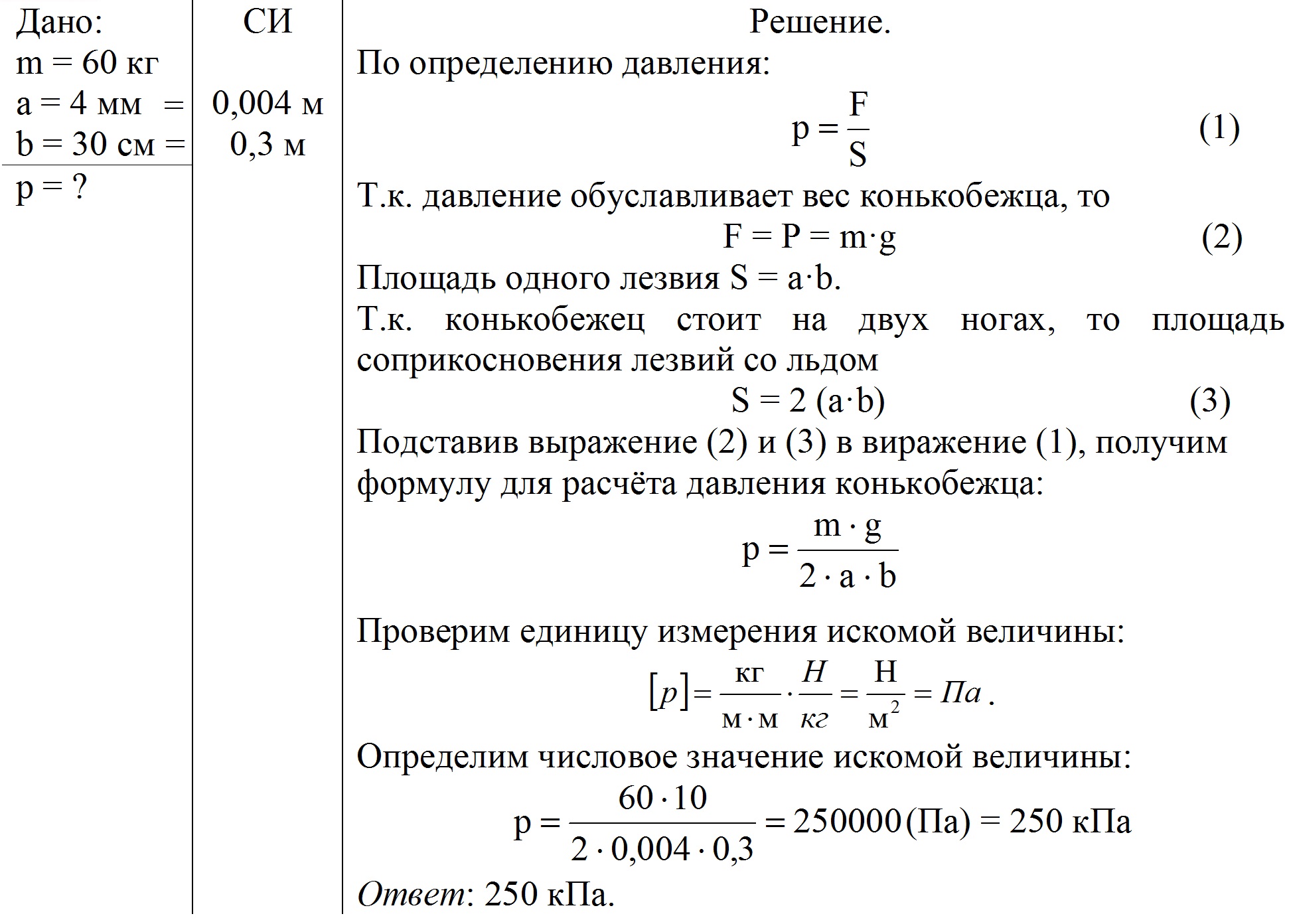
In practice, pressure units are also used. kilopascals (kPa) And hectopascals (hPa):
1 kPa = 1000 Pa
1 hPa = 100 Pa
If a load is placed on the middle of a board lying horizontally on two supports, then under the action of gravity for some time the load will move down, bending the board, and then stop.

This stop can be explained by the fact that in addition to the force of gravity directed downwards, another force directed upwards acted on the board. When moving down, the board is deformed, and a force arises with which the support acts on the body lying on it, this force is directed upward, that is, in the direction opposite to gravity. This force is called elastic force. When the elastic force becomes equal to the force of gravity acting on the body, the support and the body stop.
The elastic force is the force that arises when the body is deformed (that is, when its shape and size change) and is always directed in the direction opposite to the deforming force.
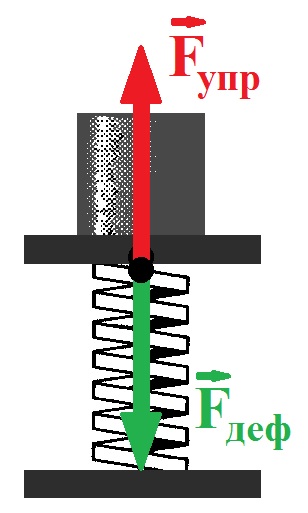
The cause of the elastic force
Cause emergence of elastic forces is the interaction of body molecules. Molecules repel at short distances, and attract at large distances. Of course we are talking about distances comparable to the size of the molecules themselves.
In an undeformed body, the molecules are located at such a distance at which the forces of attraction and repulsion are balanced. When the body is deformed (under tension or compression), the distances between the molecules change - either the forces of attraction or repulsion begin to predominate. As a result, there is elastic force, which is always directed so as to reduce the amount of deformation of the body.
Hooke's law
If one weight is hung to the spring, then we will see that the spring has deformed - it has lengthened by a certain amount X . If two identical weights are suspended from the spring, we will see that the elongation has become twice as large. The elongation of the spring is proportional to the force of elasticity.

The elastic force arising from the deformation of the body is proportional to the elongation of the body in absolute value and is directed in such a way that it tends to reduce the amount of deformation of the body.
Hooke's law is valid only for elastic deformations, that is, such types of deformation that disappear when the deforming force ceases to act!!!
Hooke's law can be written as a formula:
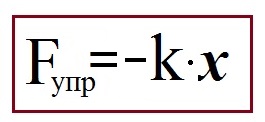
where k is the stiffness of the spring;
X- elongation of the spring (equal to the difference between the final and initial length of the spring);
the “–” sign shows that the elastic force is always directed in the opposite direction of the deforming force.
"Varieties" of the elastic force

The elastic force acting on the side of the support is called force of normal support reaction . Normal from the word "normal", that is, the reaction of the support is always perpendicular surfaces.
The elastic force acting on the side of the suspension is called thread tension (suspension) .
In the world around us, the action of one body on another cannot be one-sided. There is only .
What is the result of the interaction?
1. change in body speed;
2. .
Consider the phenomenon that the body changes its speed.
The trolley is at rest relative to the table. We attach an elastic plate to the cart, which is bent and tied with a thread. If this thread is cut, then the plate straightens sharply, but the trolley remains in its original place.
If you put another similar trolley next to the bent plate, then after cutting the thread, both trolleys will set in motion and disperse in different directions.
That is, to change the speed of the trolley, a second body was required - the second trolley.

The deformation continues until the resulting deformation balances the external forces - then the movement of body parts will stop.

Density- a physical quantity characterizing the physical properties of a substance, which is equal to the ratio of the mass of a body to the volume occupied by this body.
Density (density of a homogeneous body or average density of an inhomogeneous body) can be calculated using the formula:
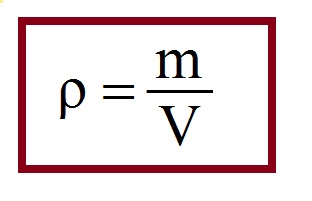
[ρ] = kg/m³; [m] = kg; [V] = m³.
where m- body mass, V- its volume; the formula is just a mathematical definition of the term "density".
All substances are made up of molecules, therefore the mass of any body is made up of the masses of its molecules. This is similar to how the mass of a bag of candies is added up from the masses of all the candies in the bag. If all the candies are the same, then the mass of the bag of candies could be determined by multiplying the mass of one candy by the number of candies in the bag.
The molecules of a pure substance are the same. Therefore, the mass of a water drop is equal to the product of the mass of one water molecule and the number of molecules in the drop.
The density of a substance shows what the mass of 1 m³ of this substance is equal to.
The density of water is 1000 kg/m³, which means that the mass of 1 m³ of water is 1000 kg. This number can be obtained by multiplying the mass of one molecule of water by the number of molecules contained in 1 m³ of its volume.
The density of ice is 900 kg/m³, which means that the mass of 1 m³ of ice is 900 kg.
Sometimes the density unit g/cm³ is used, so we can also say that the mass of 1 cm³ of ice is 0.9 g.
Each substance occupies a certain volume. And it may turn out that volumes of two bodies are equal and their masses are different. In this case, they say that the densities of these substances are different. 
Also with equal masses of two bodies their volumes will be different. For example, the volume of ice is almost 9 times the volume of an iron bar.
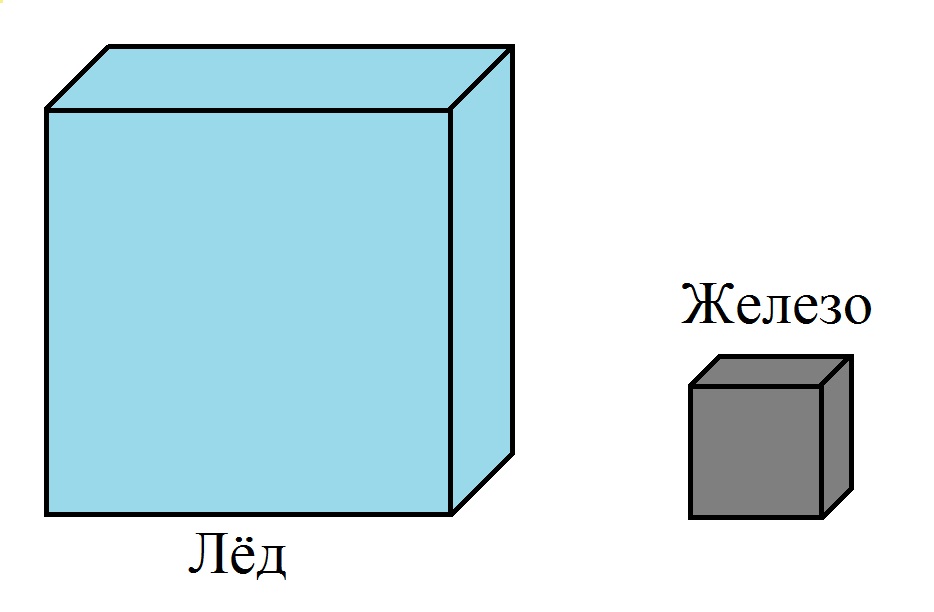
The density of a substance depends on its temperature.
As the temperature rises, the density usually decreases. This is due to thermal expansion, when the volume increases with a constant mass.
As the temperature decreases, the density increases. Although there are substances whose density behaves differently in a certain temperature range. For example, water, bronze, cast iron. Thus, the density of water has a maximum value at 4 °C and decreases both with an increase and a decrease in temperature relative to this value.
When the state of aggregation changes, the density of a substance changes abruptly: the density increases during the transition from the gaseous state to the liquid state and during the solidification of the liquid. Water, silicon, bismuth and some other substances are exceptions to this rule, since their density decreases during solidification.
Problem solving
Task number 1.
A rectangular metal plate 5 cm long, 3 cm wide and 5 mm thick has a mass of 85 g. What material can it be made of?
Analysis of a physical problem. To answer this question, it is necessary to determine the density of the substance from which the plate is made. Then, using the density table, determine which substance the found density value corresponds to. This problem can be solved in given units (i.e. without conversion to SI). 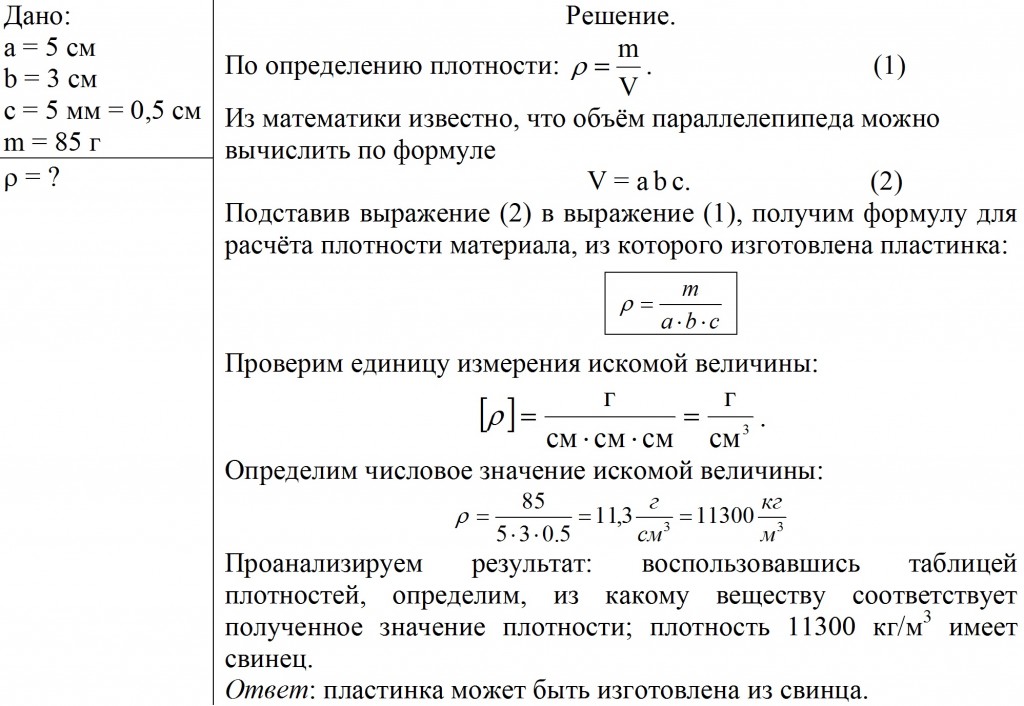
Task number 2.
A copper ball with a volume of 200 cm 3 has a mass of 1.6 kg. Determine if the ball is solid or empty. If the sphere is empty, then determine the volume of the cavity.
Analysis of a physical problem. If the volume of copper is less than the volume of the ball V honey 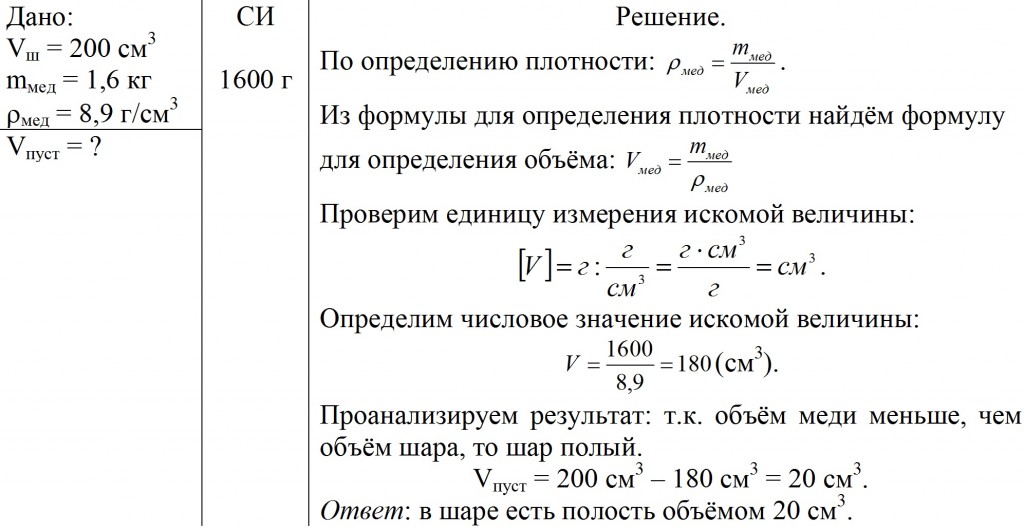
Task number 3.
A canister that holds 20 kg of water is filled with gasoline. Determine the mass of gasoline in the canister.
Analysis of a physical problem. To determine the mass of gasoline in a canister, we need to find the density of gasoline and the capacity of the canister, which is equal to the volume of water. The volume of water is determined by its mass and density. We find the density of water and gasoline in the table. It is better to solve the problem in SI units. 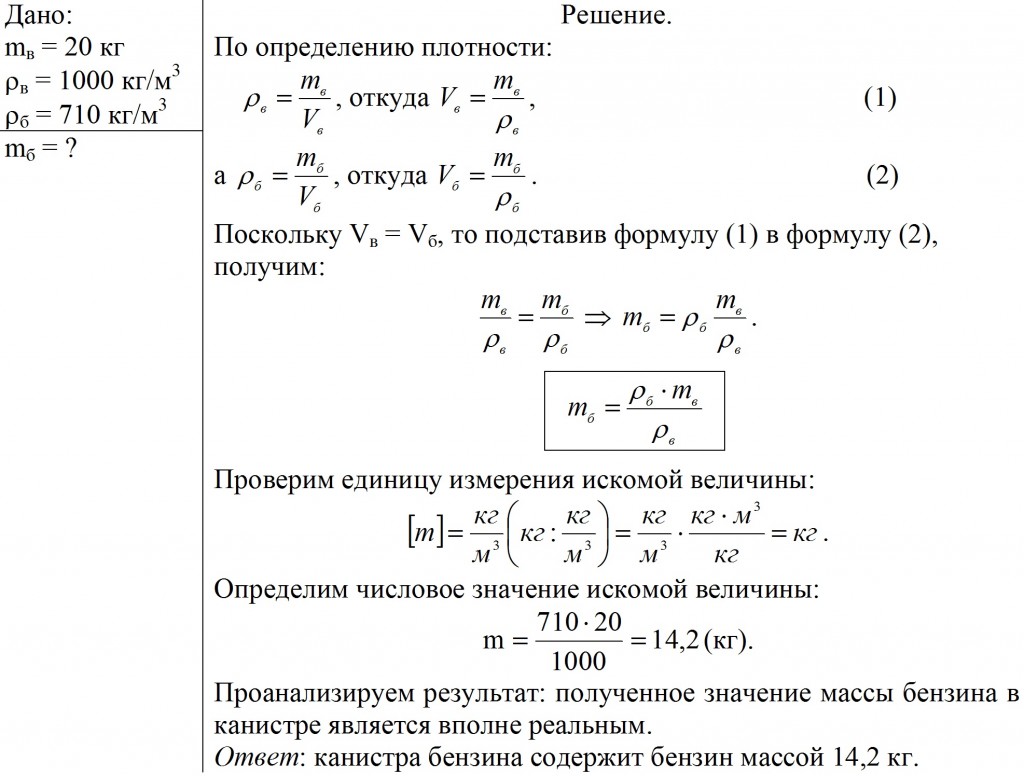
Task number 4.
An alloy was made from 800 cm 3 of tin and 100 cm 3 of lead. What is its density? What is the mass ratio of tin and lead in the alloy?
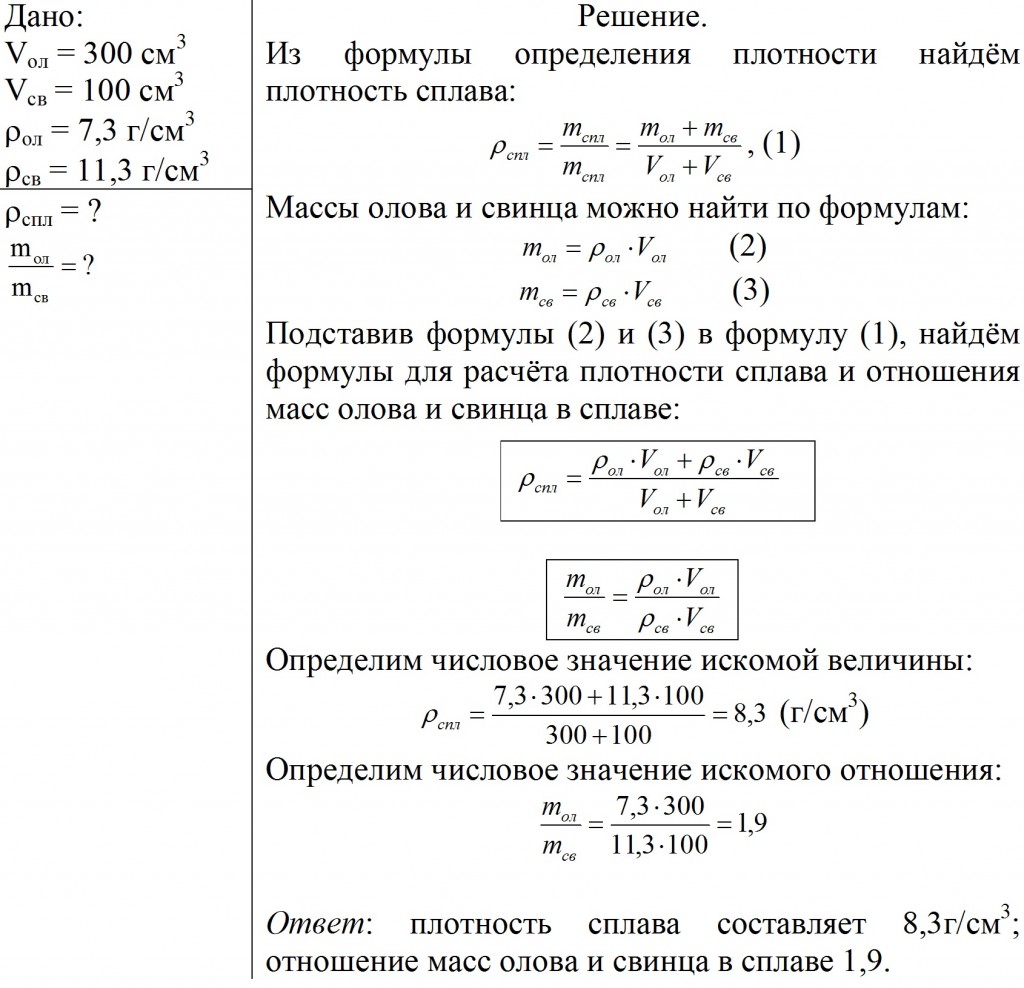
All physical bodies around us share some common properties. One of these properties is the property of bodies to be attracted to other bodies due to gravitational interaction. The measure of this property is a physical quantity called body mass.
Also, none of the bodies can change the speed of its movement instantly. As a result of the same impact, some bodies change their speed quite quickly, while others change much more slowly. For example, it takes less time to give a certain speed to a tennis ball than to give the same speed to a metal ball. In this case, the metal ball is said to be more inert. The measure of such a property of a body as inertness is - weight.
In this way, body mass is a physical quantity that is a measure of the inertial and gravitational properties of a body.
The concept of mass is one of the most complex in physics, and this concept will expand with further study of physics.
At the moment, it is enough to understand that each physical body - a person, a feather, the Moon, a microparticle, etc. - has mass.
Mass measurement
Since mass is a physical quantity, it can be measured. To measure the mass of any body, it must be compared with a body whose mass is taken as a unit.
For a unit of mass in the International System of Units (SI) is taken kilogram.
[m] = 1 kg
In addition to the kilogram, it is allowed to use, if necessary, other units of mass: tons (t), centner (c), gram (g), milligram (mg)
Multiple units:
1 t = 1000 kg
1 q = 100 kg
1 kg = 1000 g
Longer units:
1 g = 0.001 kg
1 mg = 0.001 g
1 mg = 0.000 001 kg
Since mass is one of the basic SI units, there is a standard for it. The mass standard was created in 1880 and was 1 liter of pure water at a temperature of +4ºС. However, this standard was inconvenient. The kilogram standard is made of a platinum-iridium alloy, has the shape of a cylinder 39 mm high and 39 mm in diameter.

It is stored in France, in the city of Sevres, at the International Bureau of Weights and Measures. Exact copies were made from the standard, which are available in many countries, in particular in Ukraine (in Kharkov at the National Scientific Center "Institute of Metrology").
A device for measuring body weight is called scales.
Weighing rules
1. Balance the scales.
2. Place the body to be weighed on the left scale pan and the weights on the right pan.
3. Achieve balance of scales with the body and kettlebells on the cups.
4. Place the body to be weighed and the weights onto the cups carefully.
5. Weigh loads with a mass not exceeding the maximum load.
6. Take small weights with tweezers.
When measuring the mass of bulk solids, place paper on the scales to avoid contamination of the bowl.



